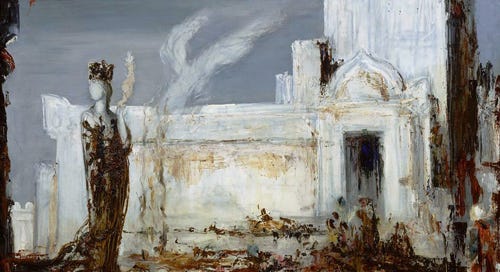Why should I blame her that she filled my days With misery, or that she would of late Have taught to ignorant men most violent ways, Or hurled the little streets upon the great, Had they but courage equal to desire? What could have made her peaceful with a mind That nobleness made simple as a fire, With beauty like a tightened bow, a kind That is not natural in an age like this, Being high and solitary and most stern? Why, what could she have done, being what she is? Was there another Troy for her to burn? —W. B. Yeats, "No Second Troy"
Yeats dedicated the above backhanded compliment of a poem to Maud Gonne, a woman he would have wanted to possess but never could, by comparing her to Helen of Troy. In the poem, “being what she is” —an unnatural beauty for the age— Gonne is described as blameless for her actions and their effects. Her agency as a revolutionary —and, understatedly, as a woman capable of choosing a lover— is taken from her, horseshoeing her into a figure of maximal objectification and devotion. She is the right woman —indeed, the perfect woman— on the wrong scale; not uniting a heroic generation —even through betrayal— but appealing to the worst and most violent in “ignorant men” by siding with them, by teaching them. She is, in brief, a flag in the wind to an anarch —all meaning and, given the context, no sense—.
I have done some previous writing on Helen at the tailend of my essay on Clemente Palma’s XYZ, and alluded to her beauty as a cautionary detonator in On Art Considered as a Non-State Actor. I continue to find her both important and importantly misunderstood.
For one, Helen connects to doubles and to simulacra in exceptionally interesting ways. As I wrote in 2017:
Isn’t Helen, the impossible woman hatched from an egg, whose kinetic beauty launched a thousand ships, the greatest eidolon in Western myth? [We’re] left with Helen as perhaps the most hermetic woman in mythology: a near un-character that —as Marlowe and Goethe both knew— was a wildcard for Beauty and could, as a result, be held up as a worthy patroness of shades.
[As] with Palma’s replicate divas, [even] the authenticity of (a single) Helen is secondary: Euripides wrote that the raptured queen remained in Egypt whilst sending a decoy to Troy, implying that the Iliad could have been waged over a double —or a hologram.
Helen is foremostly an affront to the imagination. She is unimaginably beautiful, which is why all representations of her fall short. Alonso is fond of saying Helen should be represented like a gorgon; by which I mean, without one being able to see her directly. She should be masked or veiled or turned away at all times. If I ever commission one painting, it will be that one: one of a phantasm.
Helen’s beauty is an aberration. Here is a monster of pulchritude who was first kidnapped by Theseus at the tender age of 10. The semidivine daughter of Zeus and Leda, wife of Tyndareus, she is the start of the end of her world. Her elopement with Paris is an apocalyptic trigger equivalent to the murder of Baldr in Norse myth.1
This is the other, perhaps more significant level, in which Helen challenges the contemporary imagination, as even on the matter of her rapture, it is unclear whether she is kidnapped or made to fall in love with Paris through Eros, or if she does so —love and leave— out of her own free will. Her motivations are always, necessarily, irrelevant —not even obscure.2 In a sense, she is the antithesis to Scheherazade: she tells no stories. She provokes bloodshed; Scheherazade avoids it. They are both loved by kings, but Scheherazade has to earn that king’s love over a thousand and one nights of storytelling, whereas it takes seconds for all the Achaean kings to love Helen.
Despite her infidelity and its consequences, Helen is not punished, but eventually taken back by Menelaus. She cannot be rejected, in the same way in which she cannot be recalled. She is forgiven by force of necessity, which is the same force that establishes her guilt/lessness. Hers is a genius with no agency —her purpose is served by simply “being what she is”.
There is no truth to her other than this; but it is a great truth. She is beauty, which is not value-oriented. There’s nothing more for her to be.
Gustave Moreau. Helen at the Scaean Gate. 1888. Oil on canvas. Musée Gustave Moreau, Paris.
Troy and Ragnarok have in common that they are the climaxes of their respective mythologies; both civil wars among gods. These are not foundational, cosmogenetic wars, but total, final wars. They are effectively the ends of their respective worlds. Do note that Ragnarok has yet to happen, while Troy already has.
Whereas those of her human sister, Clitemnestra, are not. Clitemnestra has undiluted agency; her motivations being central to the fall of the House of Atreus.




